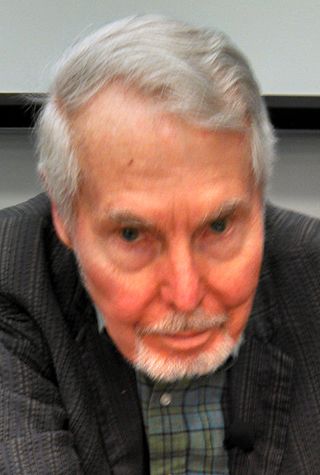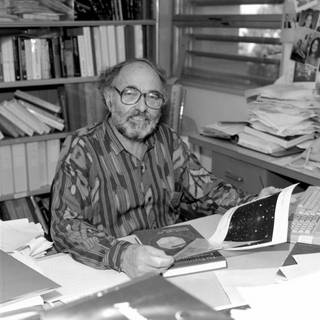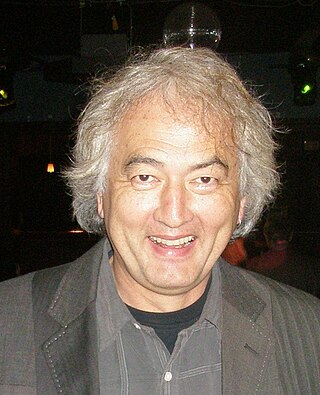Related Research Articles

Owen Chamberlain was an American physicist who shared with Emilio Segrè the Nobel Prize in Physics for the discovery of the antiproton, a sub-atomic antiparticle.

John David Jackson was a Canadian–American physics professor at the University of California, Berkeley and a faculty senior scientist emeritus at Lawrence Berkeley National Laboratory.

Darleane Christian Hoffman is an American nuclear chemist who was among the researchers who confirmed the existence of Seaborgium, element 106. She is a faculty senior scientist in the Nuclear Science Division of Lawrence Berkeley National Laboratory and a professor in the graduate school at UC Berkeley. In acknowledgment of her many achievements, Discover magazine recognized her in 2002 as one of the 50 most important women in science.

Gerson Goldhaber was a German-born American particle physicist and astrophysicist. He was one of the discoverers of the J/ψ meson which confirmed the existence of the charm quark. He worked at Lawrence Berkeley National Laboratory with the Supernova Cosmology Project, and was a professor of physics at the University of California, Berkeley as well as a professor at Berkeley's graduate school in astrophysics.

Edward Joseph Lofgren was an American physicist in the early days of nuclear physics and elementary particle research at the Lawrence Berkeley Laboratory (LBL). He was born in Chicago. He was an important figure in the breakthroughs that followed the creation of the Bevatron, of which he was the director for a time.

Inez Fung is a professor of atmospheric science at the University of California, Berkeley, jointly appointed in the department of earth and planetary science and the department of environmental science, policy and management. She is also the co-director of the Berkeley Institute of the Environment.
Christopher J. Chang is a professor of chemistry and of molecular and cell biology at the University of California, Berkeley, where he holds the Class of 1942 Chair. Chang is also a member of the Helen Wills Neuroscience Institute, a Howard Hughes Medical Institute investigator, adjunct professor of pharmaceutical chemistry at the University of California, San Francisco, and faculty scientist at the chemical sciences division of Lawrence Berkeley Lab. He is the recipient of several awards for his research in bioinorganic chemistry, molecular and chemical biology.
Wick C. Haxton is an American theoretical nuclear physicist and astrophysicist. He is a professor of physics at the University of California, Berkeley and senior faculty scientist at Lawrence Berkeley National Laboratory. He was appointed a co-editor of the journal Annual Review of Nuclear and Particle Science as of 2023.

John William Harris is an American experimental high energy nuclear physicist and D. Allan Bromley Professor of Physics at Yale University. His research interests are focused on understanding high energy density QCD and the quark–gluon plasma created in relativistic collisions of heavy ions. Dr. Harris collaborated on the original proposal to initiate a high energy heavy ion program at Cern in Geneva, Switzerland, has been actively involved in the CERN heavy ion program and was the founding spokesperson for the STAR collaboration at RHIC at Brookhaven National Laboratory in the U.S.
Gail G. Hanson, born 22 February 1947 in Dayton, Ohio is an American experimental particle physicist.
Lowell S. Brown was an American theoretical physicist, a retired Staff Scientist and Laboratory Fellow at Los Alamos National Laboratory, and Professor Emeritus of physics at University of Washington. He was a student of Julian Schwinger at Harvard University and a recipient of the John Simon Guggenheim Memorial Foundation Fellowship. Brown authored a book on Quantum Field Theory that has received over 5,000 citations, and he has authored or co-authored over 150 articles that have accumulated over 11,000 citations.

Fernando Pérez is a Colombian-American physicist, software developer, and free software advocate. He is best known as the creator of the IPython programming environment, for which he received the 2012 Free Software Award from the Free Software Foundation and for his work on Project Jupyter for which he received the 2017 ACM Software System Award. He is a fellow of the Python Software Foundation, and a founding member of the NumFOCUS organization.

Michael Stewart Witherell is an American particle physicist and laboratory director. He has been the director of the Lawrence Berkeley National Laboratory since 2016. Witherell, a particle physicist, previously served as Director of Fermilab. He previously served as professor and vice chancellor for research at the University of California, Santa Barbara.

Arthur M. Poskanzer was an experimental physicist, known for his pioneering work on relativistic nuclear collisions.
Edwin L. Goldwasser was an American physicist and Co-Founder of the Fermi National Accelerator Laboratory and the field of particle physics. He was a Professor of Physics Emeritus and former Vice Chancellor of Academic Affairs at the University of Illinois, as well as the first Deputy Director of Fermi National Accelerator Laboratory. His interests were photons, cosmic rays, charged particles and elementary particles. He was Fellow to the American Association for the Advancement of Science and American Physical Society. He was a Guggenheim Fellow for the academic year 1957–1958.
M. Zahid Hasan is the Eugene Higgins Professor of Physics at Princeton University. His primary research area is quantum physics and quantum topology.
Martin B. Einhorn is an American theoretical physicist.
George H. Trilling was a Polish-born American particle physicist. He was co-discoverer of the J/ψ meson which evinced the existence of the charm quark. Trilling joined the Physics Department faculty at the University of California, Berkeley, in 1960, where he was Department Chair from 1968 through 1972. Trilling was on sabbatical leave to CERN in 1973–74, where he worked on the study of the properties of charm particles, their decay modes and excited states. He was also Director of the Physics Division at the Lawrence Berkeley National Laboratory from 1984 until 1987. Trilling was a principal proponent of the Superconducting Super Collider project and spokesperson for the Solenoidal Detector Collaboration. After the SSC was cancelled in 1993, Trilling transitioned most of the SDC team to collaborate on the ATLAS experiment at the LHC, which led to the discovery of the Higgs boson in 2012. Trilling was elected Vice-President of the American Physical Society, beginning his term on 1 January 1999, and was President of the society in 2001.
Natalie Ann Roe is an experimental particle physicist and observational cosmologist, and the Associate Laboratory Director for the Physical Sciences Area at Lawrence Berkeley National Laboratory (LBNL) since 2020. Previously, she was the Physics Division Director for eight years. She has been awarded as the Fellow of American Physical Society (APS) and American Association for the Advancement of Science (AAAS) for her exceptional scientific career and contributions.
References
- 1 2 "William Chinowsky (E) | UC Berkeley Physics". physics.berkeley.edu. Retrieved 2022-06-01.
- 1 2 LBL Research Review. Lawrence Berkeley Laboratory. 1985.
- ↑ Amanda Solliday. "The November Revolution". symmetry magazine. Retrieved 2022-06-01.
- ↑ "Smoot Group Cosmology". aether.lbl.gov. Retrieved 2022-06-01.
- ↑ "In the Groove | Columbia College Today". www.college.columbia.edu. Retrieved 2022-06-01.
- ↑ California (System), University of (1965). University Bulletin: A Weekly Bulletin for the Staff of the University of California. Office of Official Publications, University of California.
- ↑ "William Chinowsky". John Simon Guggenheim Memorial Foundation. Retrieved 2022-06-01.